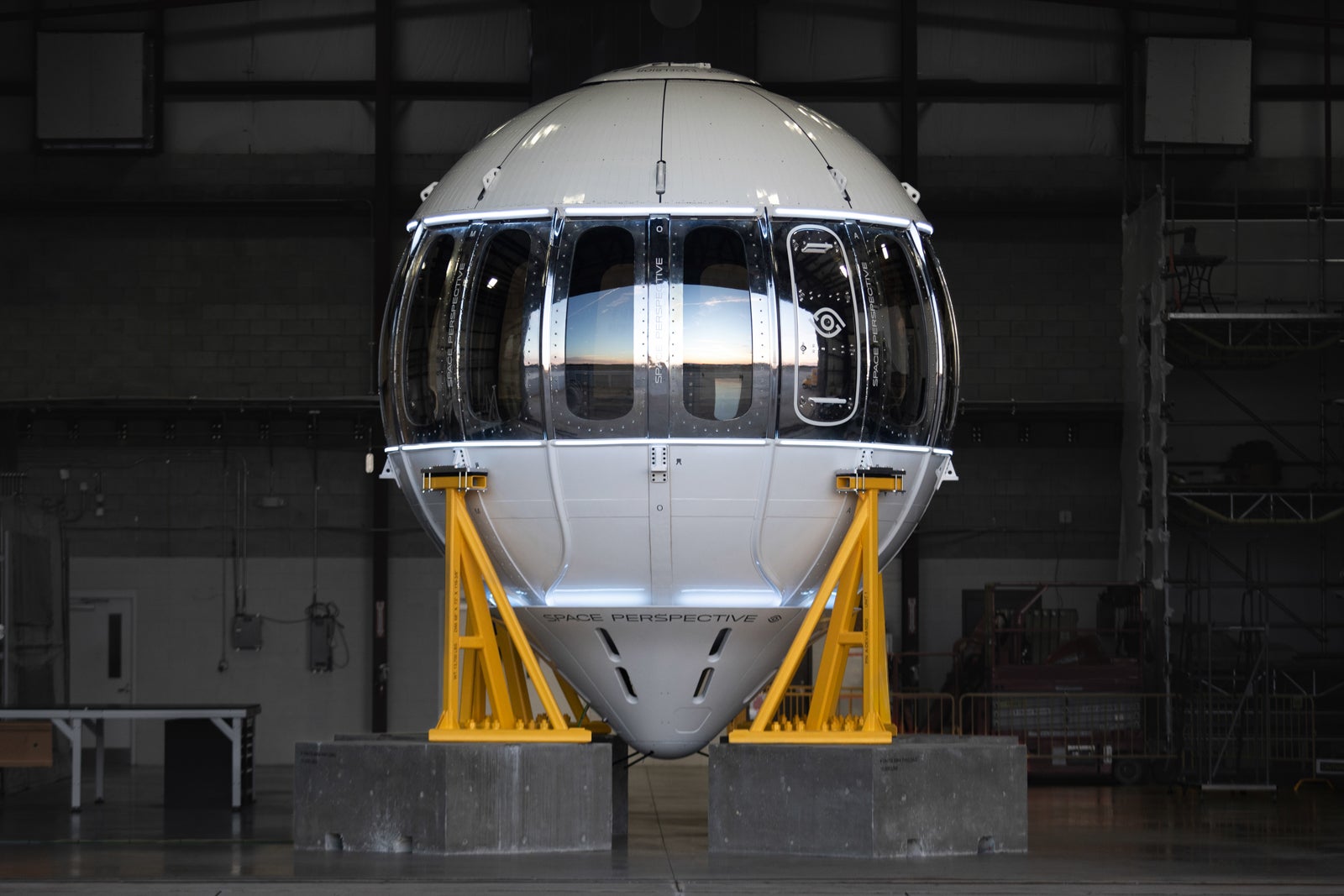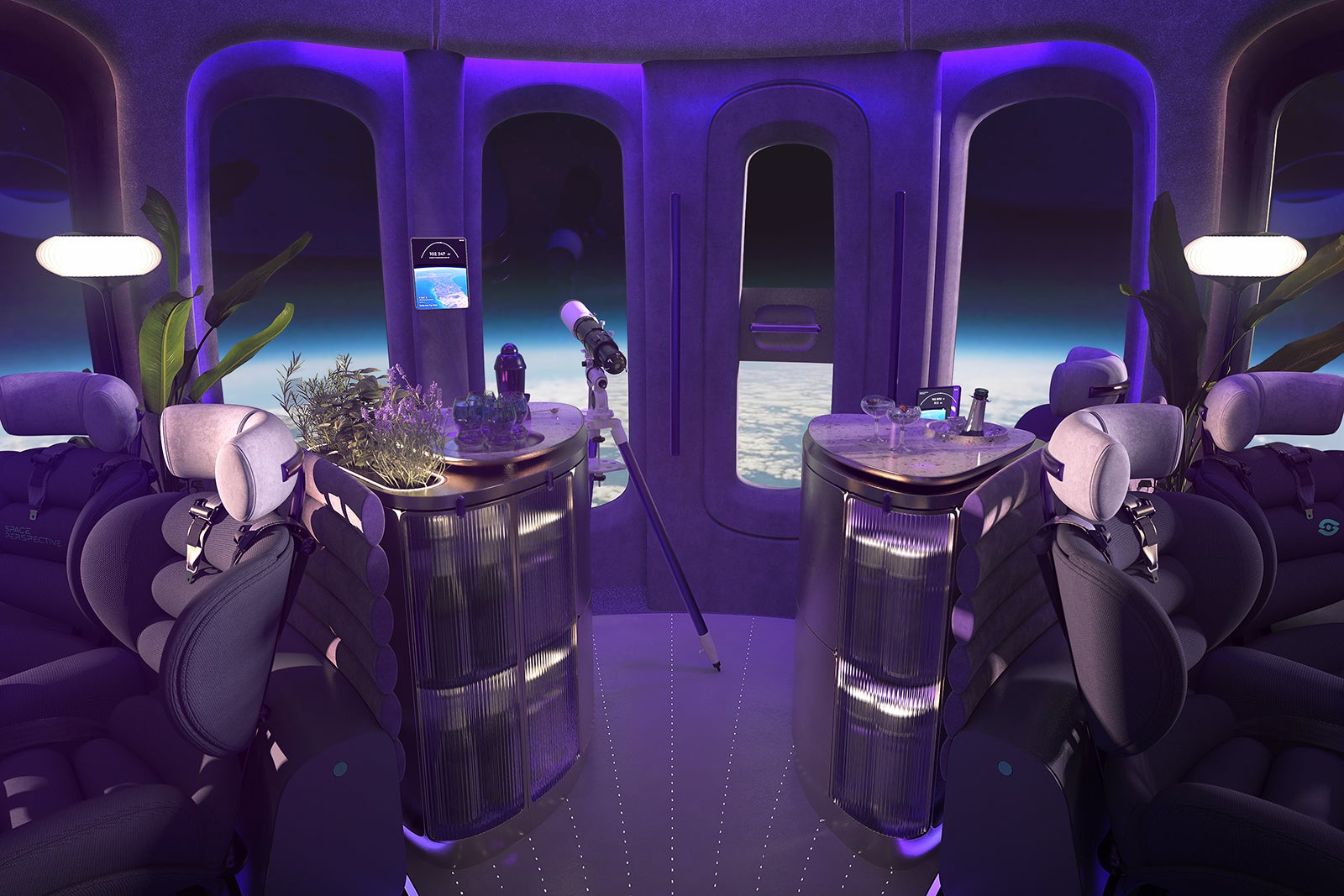Space Perspective to launch first manned flight in 2025
These amenities are commonplace at 35,000 feet, but a new tourism company is about to take the luxury flight experience to all-new heights — 100,000 feet, in fact. Space Perspective, the first company to offer stratospheric flight experiences, has completed its unmanned test flight on Sept. 15, 2024. The successful test flight marked a major milestone, and it paved the way for future commercial flights and the company’s first manned flight, which will take place in 2025.
Related: Want to live in or visit space? This exhibit offers a preview
TPG spoke with Space Perspective co-founder Taber MacCallum and interim CEO Michael Savage to learn more about the company’s unique brand of space tourism and what the experience will entail.
What is Space Perspective?
SPACE PERSPECTIVE
Without a rocket, how does Space Perspective transport travelers to the stratosphere and return them safely to Earth? The Spaceship Neptune is a 16-foot diameter spherical capsule that can carry up to eight passengers, including a captain. The Voyager currently calls Cape Canaveral, Florida, home but is designed to launch from marine-based sites across the globe.
According to MacCallum, a typical flight will start in the morning (though if you purchase a ticket, I assume you will have some sway over your launch time). He explained that the balloon would be inflated so that it was standing over the capsule, with the capsule attached to the deck. Then, the passengers will be allowed to enter the capsule and receive a safety presentation, much like a pre-flight briefing in a commercial aircraft. “
The Spaceship Netptune capsule is then gently lifted from Voyager via Space Perspective’s patented SpaceBalloon.
When the capsule is released from the launch vessel, it will gently ascend at about 12 miles per hour for two hours, a rate at which MacCallum likened to bicycling speed. Then, we will stay floating at 100,000 feet above the Earth’s surface for two hours. “
Daily Newsletter
Reward your inbox with the TPG Daily newsletter
Join over 700,000 readers for breaking news, in-depth guides and exclusive deals from TPG’s experts[the highest altitude of any commercial balloon flight in the world]MacCallum continued: “Then we begin the descent, which is sort of the reverse of the ascent. The splashdown is about 2 hours away. A retrieval ship will be waiting at the splashdown site. “
Boats stabilize the capsule, and lift it onto the Voyager. This process takes around 20 minutes. I wanted to know how the name Neptune was derived. MacCallum’s answer did not disappoint.
“It came to me in a dream,” MacCallum told me. I literally dreamed that it was the Spaceship Neptune. It has a pleasant ring, but MacCallum, who is well-known for his ballooning and space travel history, also holds an important scientific meaning. He explained that Neptune’s atmosphere is made up of helium and hydrogen, which is the same type of “lift gas” used to lift balloons into the air. Neptune’s atmosphere is essentially made of the types of “lift gas” used to lift balloons into the air.
Who regulates space tourism?
SPACE PERSPECTIVE[where a Splashcone at the capsule’s base will facilitate a gentle water landing]When you combine a marine-based launch point and a spacecraft, you get, in MacCallum’s words, “a lot of regulators. “
The Office of Commercial Space Transportation of the Federal Aviation Administration regulates everything that flies, including the ground operations that are connected with it. The Coast Guard regulates everything that we do on board. “
Though the FAA does not have a defining limit for what is considered the edge of space, it does classify any vehicle intended to operate about 30 kilometers (or about 98,000 feet) with people inside it as a spacecraft.
“Once you’re at 30 kilometers or above, you are essentially in space,” MacCallum said. It’s basically a vacuum and all the navigation, thermal and radiation concerns that an aircraft has. “
Even though Space Perspective may one day launch outside the U.S. it will still be subject to the Outer Space Treaty of 1969 as a spacecraft. MacCallum said that no matter where Space Perspective is located, it will be regulated by FAA. “We are U.S. citizens, and we run a U.S. operation. So, we won’t change,” he explained. Most countries are signatories to the treaty, giving Space Perspective the ability to operate worldwide.
A focus on the passenger experience
From the moment you take off to the moment you land, Space Perspective will provide the comfort, space and amenities to let you fully enjoy this remarkable experience.
The capsule is surrounded by floor-to-ceiling windows for panoramic views of the scenic journey above Earth. The seats are designed with safety and comfort elements that rival that of any commercial aircraft, and you’ll enjoy a world-class food and beverage service while on board.
SPACE PERSPECTIVE
Even the restroom, dubbed the “Space Spa,” would put the restroom in a first-class airplane cabin to shame. Space Perspective’s team did not miss a detail in designing the Neptune capsule or the in-flight experience. This included working with Sir Richard Branson who will be the co-pilot of the first crewed trip. The other co-pilots will be MacCallum and his wife, Jane Poynter, who is a co-founder of Space Perspective.
“Richard is a very experienced balloonist,” Savage told TPG. Branson’s involvement is far beyond the typical investor. “This is a project he’s personally passionate about and he brings his expertise along with his commitment towards the customer experience. “
While he wasn’t involved in the early stages, it is clear that Space Perspective shares Branson’s passion for exceeding customer expectations. “There are challenges that come with things like flying the largest windows in space, but we made it happen because Jane wanted to drive experience,” Savage said.
Prioritizing customer experience similarly informed the layout of the capsule. MacCallum explained that initially, they thought everyone would want to sit in front of the window and would have a sort of ring of seating. We immediately realized this was a social event that people wanted to share. So we rearranged the seats into two sets of four hemispherical chairs that would better facilitate such an interaction. The extended six-hour time frame allows guests to enjoy their time in outer space in the way that they feel most comfortable. If you want to join the select few who are able to tag their Facebook location “space”, you will need to spend $125,000 on a standard Space Perspective flight ticket. To date, Space Perspective has sold more than 1,800 reservations.
Many of those are for families or friend groups who want to go on the ultimate getaway, but Space Perspective has received some pretty “out of this world” requests, as well. MacCallum revealed that people have already purchased several tickets to see Italy, after viewing Florida from the edge. Savage stated that the long-term roadmap could include overnight experiences. We have the capability to create custom experiences. As we move forward, I am sure there will be many fun things that people can do. “
How does it differ from other types of space tourism?
SPACE PERSPECTIVE
Unlike other experiences offered by space tourism companies, a Space Perspective flight is slow and gentle. Rather than a speeding journey to space and the weightlessness and g-forces that come along with it, a Space Perspective flight is closer to the experience of flying in an airplane.
That doesn’t mean the two experiences are in competition with one another. MacCallum revealed that Branson sees both as complementary. He said that someone who was too afraid to fly in a rocket could do this first. “They’re such different experiences, he doesn’t see them at all as competition. Savage explained that Space Perspective provides the type of transformative experience that astronauts describe after seeing Earth from a different vantage point. Space Perspective, on the other hand, provides the type of transformative experience that astronauts describe after seeing Earth from a different vantage point.
“Many astronauts will tell you that they became an astronaut to go explore space, but what they discovered was that their relationship to Earth was forever changed,” Savage explained.
“The slow ascent and descent Space Perspective provides gives you an understanding of scale that you don’t get with a rocket. You can look out the window and see your neighborhood and then your community and your state and realize, ‘Maybe this Earth isn’t as big as I thought it was and I should take better care of it,'” he added.
By the end of the journey, passengers will have spent six hours traveling to and from the stratosphere, with two full hours built in to look down on our planet from a vantage point very few will ever reach.
Space Perspective is set on making this life-changing journey accessible to as many people as possible.
“Imagine if every school had a teacher who’d actually been to space,” Savage, whose two sisters are school teachers, said. They could speak to children about space exploration and bring about radical changes. “
There are already charities that form to send teachers and other leaders into space,” MacCallum said. Space for Humanity is raising money for people to go on such experiences. There is a growing philanthropic element to sending people into space. Virgin Galactic, Blue Origin and other companies have already sent people there. Space was once thought of as the final frontier, at least according to “Star Trek.” Now, Space Perspective will soon take passengers “where no man has gone before” in luxury and comfort.
With high-end amenities, panoramic views and a gentle, six-hour flight to soak it all in, Space Perspective’s “atmospheric” journey to the stratosphere is redefining the meaning of space tourism.
Related reading:





